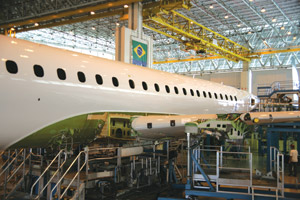
Features
Operations
Embraer’s Big Biz Jet: When business travel demands more
One of the things you have to love about corporate aviation is that it’s always changing. There is frequently a new trend or development to take in.
October 8, 2008 By Rob Seaman
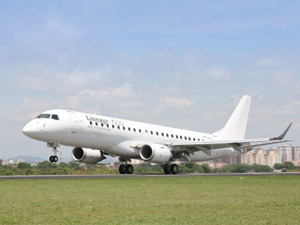
Power for the Lineage 1000 comes from two efficient, reliable and easy-to-maintain General Electric CF34-10E7-B engines.
|
One of the things you have to love about corporate aviation is that it’s always changing. There is frequently a new trend or development to take in. However, look back not so many years and the original business or private aircraft was inevitably a revamped “something or other.” As an example, the B25 bomber that graced the CBAA static display this year was once a corporate aircraft for the Bendix Corporation. Many DC-3s, Venturas and even some heavy bombers found similar roles. So that’s how corporate aviation got started – by borrowing from other aspects of aviation. The industry then began to grow its own. The Lockheed series, early Lear and Falcon jets were the trailblazers. Mixed in were redone commercial aircraft – continuing the borrowing from others, you might say. That aside, the mold was set for small, efficient and fast jet or turboprop aircraft. The rest, as we know, is history.
Today, however, we find ourselves in a trend to go bigger and go further and once again borrow a bit from the commercial realm. Around the world, sales of larger biz-jets are solid. Not just Globals, Challengers, Falcons and Gulfstreams. Folks want BBJs, ACJs and even the odd A380 or Dreamliner. And the wait lists associated with these built-in options are growing.
For the corporate traveller whose routes are more international than domestic, comfort, function, utilization and size matter the most. And with time-zone shifting a part of such travel, camping out in a chair – even though the seats easily outclass even the best first class on commercial – and hunkering down with a pillow or blanket for the overnight trip, isn’t the only option. Today, you can get an aircraft that offers distinct living and sleeping areas with full amenities like a proper stand-up shower, top-notch galley, separate crew areas and, given the right budget, all the perks and add-ons your heart desires.
Both Airbus and Boeing offer all their aircraft in some corporate option. Such a sale is usually in two parts: there is one price for the aircraft and a second for the completion. As for the completion, the choice is usually between several established, completion places where the aircraft is taken from the factory as a primer-green, flying shell. The magic that occurs is the fit and finish to incorporate the owner’s choices for the interior and even exterior appearance. Cost for a BBJ, finished and delivered to the owner can run easily in excess of $65-70 million US today. Even a Gulfstream or Global XRS can be up in the $50 million US-plus range.
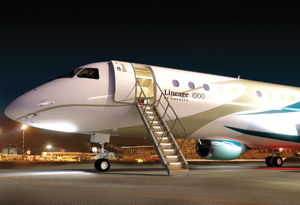
The Lineage is based on Embraer’s highly successful E190.
|
Enter Embraer with a new option called the Lineage 1000. Yes, it is a big airplane. And yes, it’s based upon one of its highly successful commercial aircraft, the E190. Beyond those facts, this aircraft tells a completely different story from the other guys. The Lineage is one corporate big jet where the OEM sells a complete and finished aircraft – from the first piece of framework being laid into a jig, through to the last curtain hung on the windows. Some have called this a lightweight in the cabin finish department. The truth is, however, that the owner still gets to choose certain upgrades and options to make it personal. The big difference is that unlike the others, Embraer sells the aircraft inclusive of a very nice and well-planned interior and exterior paint finish. When delivered to the owner, the Lineage is a true turnkey aircraft and has a cost of $42.9 million US with a standard configuration. True, it’s a bit smaller than the Airbus and Boeing options, but it easily holds its own as a big corporate jet and offers significantly more cabin than some of its competitors. For its part, the business community seems to like this option – so far Embraer reports 20 firm orders with certification expected by the fourth quarter of this year.
The basic, from-the-factory Lineage 1000 cabin configurations should satisfy all traveller needs. There is plenty of room for work, rest and meetings. Among the optional items are the most in-demand bizav components of today such as Wi-Fi technology, internet access and LCD displays up to 42-inch, satellite TV & radio, DVD, CD and MP3 connections. Airshow 4000 moving map will be available along with the latest-generation cabin management system that provides full control for temperature, lighting and window shading, and audio and video. There are also pilot enhancements such as Electronic Flight Bag (EFB).
Differentiating itself from current competitors comes through Embraer’s incorporation of ultimate business jet solutions – right down to some details often overseen by others. The entire interior is outfitted with the most refined materials in the category with a fully seamless integration (there are neither airline-type interior doors nor airline-like materials in use). The Lineage may be based on an airliner, but this aircraft is all bizjet!
When you travel on an aircraft of this size, it’s nice to know you can carry just about anything you want. The total baggage capacity of the Lineage is 471 cubic feet. There is a large, pressurized aft baggage area, which is conveniently accessible during flight and it’s more than twice the size of baggage compartments on comparable jets.
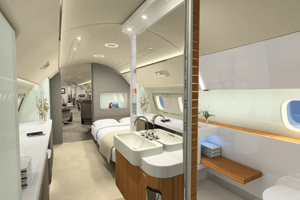
For the corporate traveller whose routes are more international than domestic, comfort, function, utilization and size matter the most.
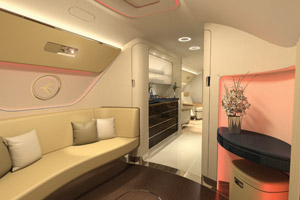
The Lineage 1000 was designed with comfort and luxury as top priorities. The interior, designed in partnership with Priestman Goode from the U.K., offers five distinct privacy zones and two lavatories.
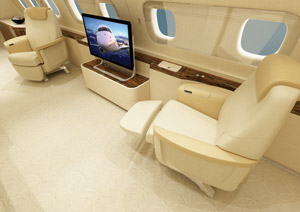
Among the optional items are the most in-demand bizav components of today such as Wi-Fi technology, Internet access and LCD displays up to 42-inch, satellite TV and radio, DVD, CD and MP3 connections. |
As for the technology, Embraer is well known for thinking things through to make the pilot’s world efficient. In addition to the EFB options, the Lineage offers a highly integrated avionics suite based on Honeywell’s Primus Epic system. The most visual part is the five Liquid Crystal Display (LCD) multifunction control screens that are front and centre in the cockpit. As you scan further you’ll see a Cursor Control Device (CCD), auto-throttle, weather radar with turbulence detection, fly-by wire, and other cutting-edge technologies.
Power for the Lineage 1000 comes from two efficient, reliable and easy-to-maintain General Electric CF34-10E7-B engines. Providing 18,500 pounds of thrust each, they will propel the Lineage with eight passengers up to 4,200 nautical miles – including NBAA IFR reserves and a 200 nm alternate. The Lineage has a maximum operating speed of Mach 0.82, and is capable of flying at 41,000 feet.
What was the driving force behind the Lineage’s creation, especially when there were already other new-from-the-factory options from Boeing and Airbus, plus all sorts of aftermarket remakes? Is there room or demand for another contender in this larger bizjet segment? Embraer says the creation of the Lineage 1000 was based on a solid market assessment which demonstrated that the ultra-large market was a positive one. The research also showed that with multiple cabin zones and the price/performance combination of the Lineage, it could result in a very competitive product. With this as its starting point, Embraer found that the Lineage 1000 could be developed from a suitable platform (the E190) with reduced investment, low development risk and a fast development cycle (time-to-market).
As the price of fuel continues to climb, the discussion inevitably comes down to scales of economy surrounding the Lineage vs. other wide-cabin bizjets. The direct operating costs (DOC) for the Lineage 1000 is $4,058 US/hr (Conklin & de Decker fall 2007 assumptions).
Some say it’s better to buy an old commercial aircraft and simply pay for the cabin and exterior refit and refinish, as opposed to ordering a new aircraft like the Lineage, BBJ or Airbus ACJ. The aircraft conversion market dominated this segment from the sixties to the early nineties. But after the arrival of the dedicated ultra-large models and ultra-long range airplanes, refurbing old airliners declined to a small portion of the market. This, according to Embraer, indicates that the market is not willing to cope with high operating costs, difficulties associated with operating at restrictive airports, and high maintenance costs and low maintenance intervals that are associated with older commercial type conversions. Moreover, because of today’s environmental concerns, there may be negative image associated with operators of such airplanes.
Speaking of the environment, Embraer has a well-earned reputation for being responsive and proactive to the global good. The Lineage 1000 is an example of Embraer’s environmental commitment heritage. When developing the E-Jets, Embraer developed a full suite of latest-generation technological tools and processes such as full-digital mockup with Catia, Virtual Reality Centre, latest-generation CFD simulations, Integrated Development Teams and more. This resulted in a new generation of airplanes, incorporating all ultimate technologies and features, such as state-of-art avionics, sensors and control systems, fly-by-wire, latest-generation engines and noise abatement features. As a result, the E-Jets produce an average of 50 per cent less CO2 than older aircraft and 15-30 per cent less than previous-generation jets, while meeting and exceeding the latest, stricter noise limits set by ICAO. Embraer has been ISO 14001 certified since 2002. It is also increasing recycling efforts annually. In 2006, it recycled 80 per cent of eligible materials and are still investing in even “greener” facility operations.
Keeping their commitment from the E-Jets heritage, Embraer feels that the Lineage 1000 is the most environment-friendly ultra-large executive jet. It will exceed the latest ICAO Stage IV noise regulations, effective from January 2006. In addition the Lineage 1000 will comply with the most noise-restrictive airports around the world, providing an environmentally friendly option for local communities around these airports, such as London City, Washington National and others.
For its part, Embraer has taken the Canadian market seriously. So much so that one of the busiest guys in this market today is Mike Payne, Embraer’s resident and native company representative. With the interest he seems to be finding in all the Embraer products – and the continued good health of corporate aviation here at home – it will without question only be a matter of time before we see a Lineage on the Canadian C of A.
